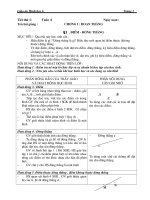GA TA!@
Bạn đang xem bản rút gọn của tài liệu. Xem và tải ngay bản đầy đủ của tài liệu tại đây (82.35 KB, 2 trang )
Task 2-Listening
Here is a list of the techniques that can be used in the pre, while, or post stage of a listening
lesson.
Match each of the techniques with its description, and then decide which stage it belongs to.
Techniques
Description
Stage
1) Grid completion
a. The teacher (T) prepares questions about the
ideas in the listening text. For each question, there
are three or four options for students (Ss) to choose
from.
2) Open prediction b. T writes 5 – 10 statements about the main points
of a text. Half of the statements are true, and the
other half are false. Ss are asked to work in pairs
and decide if the statements are true or false. T
writes the students’ guesses on the board. Ss are
asked to listen to the text to check the answers.
3) Multiple choice
c. T writes a short paragraph with several blanks in
it. The blanks can be lexical or grammatical items
or both. Ss listen and fill each blank with
information they hear.
4) Ordering
pictures
d. T writes a few questions on the board. These
questions should focus on the main ideas of the text.
T gives students a few minutes to guess the answers
to the questions. It doesn't matter if Ss can't guess
correctly.
5) Gap-fill
e. T writes some true and some deliberately false
statements about the text on the blackboard. Then
Ss listen to the text to find out which are correct.
6) Ordering
statements/
events
f. These are the questions related to the main ideas
of a text to check students' comprehension. Ss listen
and answer questions from T or from the textbook.
7) Short written
texts
g. T prepares some simple pictures to describe a
story or a text, and sticks them on the board
randomly. Ss listen to the text and arrange the
Presented by H-Tiep
pictures in the correct order.
8) True/false
statements
h. Ss write letters, postcards, messages, diaries, etc
based on the listening text or to extend it.
9) Pre-questions
i. T writes about 6 to 8 statements on the main
points of a text but the statements are jumbled. Ss
listen to the text to find out the order of the
statements.
10) Comprehensio
n questions
j. T draws a grid on the board. This grid will
contain the main information of the text. Ss are
asked to listen to the text and fill in the gaps with
information heard. Then they are asked to write the
information in the grid on the board.
11) True / false
prediction
k. Ss discuss similar or related issues based on
prompt questions or pictures.
12) Retelling
the story
l. T establishes a context and introduces the topic of
a text. Ss are required to guess what they are going
to listen to. T (or Ss) writes the Ss’ guesses on the
board. Ss are asked to listen to the text to check if
things they guess are correct or not.
13) Discussion m. T writes the network on the board. Ss are
required to work individually to find ideas related to
the topic of the network and then compare their
answers in pairs or groups. T collects the ideas from
Ss.
14) Role play
n. Ss retell the story in groups, using their own
word or using some provided cues.
15) Network o. Ss summarize the whole text or a pre-selected
part orally or in writing.
16) Summarizing p. Ss continue the story or situation by assuming
the roles of people in the texts.
Presented by H-Tiep









